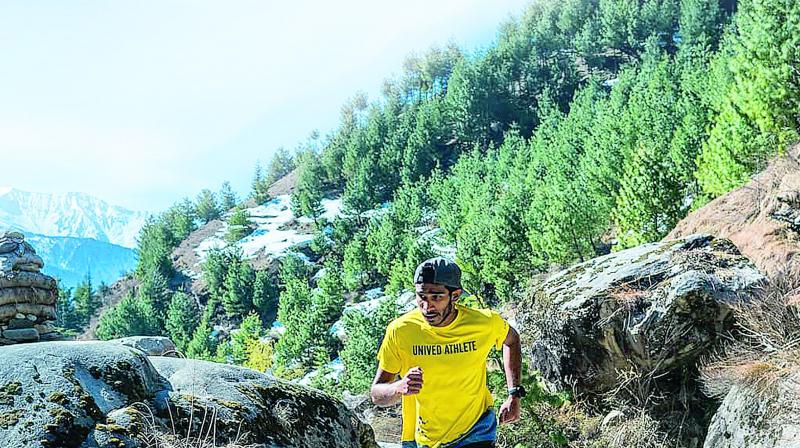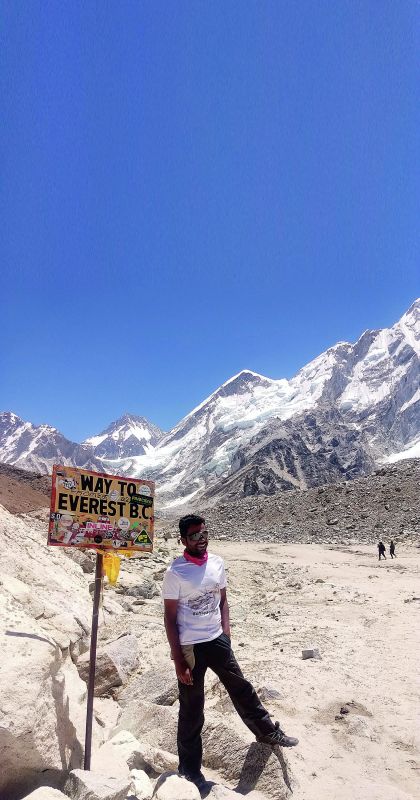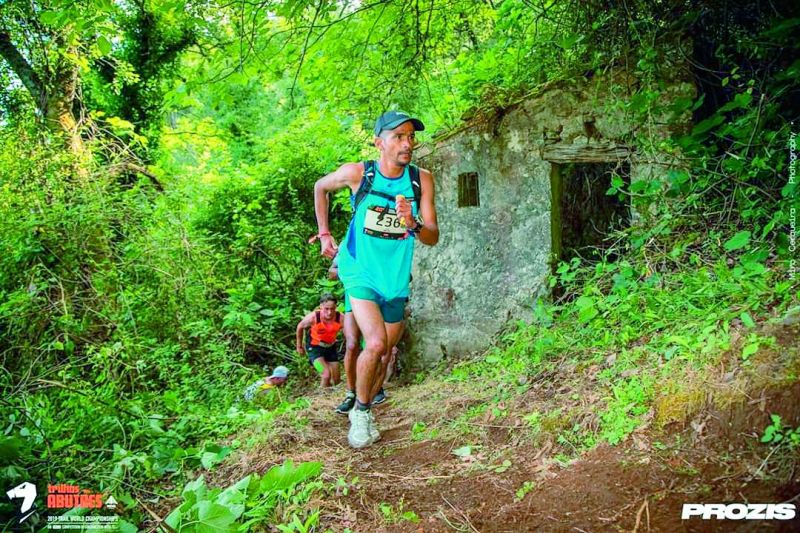Run the EXtrA MILE
The very popular ultramarathons have races organised in terrains like deserts, steep cliffs, forests and high altitude ranges.

If you want to run, run a mile. If you want to experience a different life, run a marathon. If you want to talk to God, run an ultra.
– US ultramarathoner Dean Karnazes on Twitter
A 42.2-km race against a fast-ticking clock with adrenaline and blood pumping through the system and pressure building up, a marathon has been, for long, considered the ultimate test of human endurance. With man testing his limits taking new twists and turns every day, the running distance has upped to 160 km and sometimes even further in the challenging sport popularly known as the ultramarathon.
 Anenthu Sukumaran on his way to the Everest base camp
Anenthu Sukumaran on his way to the Everest base camp
Having witnessed a growing number of ultra runners regularly tackling great distances on terrains like deserts, steep cliffs, forests and high altitude ranges, India now boasts of hosting some of the world’s most challenging ultramarathons. What makes the adventure run interesting is that ultra runners are not super men or wonder women, but regular runners who are high on the idea of pushing themselves to the edge. They are also those people who relish the joy of running while getting a whiff of nature, preferring bird songs to vehicle horns, treading on snow rather than cement. The country’s popular and dangerous marathons include the Kargil International Marathon, Tenzing Hillary Everest Marathon, La Ultra, Hell Ultra, Thar Run and the Uttarkashi 135.
 Tlanding running the Mawkyrwat Ultramarathon
Tlanding running the Mawkyrwat Ultramarathon
Nature cheers for the runner
‘The tougher the race the better’ is the mantra of Anenthu Sukumaran, who finished the 60-km Extreme Ultra category of the Tenzing Hillary Everest Marathon in 16 hours — the best timing recorded by an Indian till date.
Held at lung-bursting altitudes of 17,000 feet, this ultra marathon is the world’s highest marathon conducted from the Mt. Everest Base Camp annually to commemorate the historical ascent of the peak by Tenzing Norgay and Edmund Hillary
Remembering reaching the finish point of the marathon, Anenthu exults, “I was on cloud nine!” Other than mountaineers, only Everest Marathon participants are allowed to stay overnight at the base camp. “The race course for Extreme Ultra 60k was really ‘extreme’ — both physically and emotionally. The race started on the slippery Khumbu glacier and then proceeded to the plains of Gorakshep past the narrow paths on the cliffs of Phortse, where choppers fly below you, and then through the never-ending steps at Mong-La and Kyangjuma.”
Before becoming an ultramarathoner, Anenthu travelled to almost all corners of India and then started participating in half marathons, full marathons and finally ultramarathons. “Once I found that my body could accept the physical extremes required for regular marathons, I raised the bar higher and ended up participating in ultramarathons, which are closer to nature and Mother Earth.”
Anenthu did not take his preparations or the race lightly, “I was cautious with each step to keep my body injury-free; crossing the finish line was always a second priority!” He states that in ultra marathons, mind plays a major role over body.
When he switched to ultramarathons in 2015, Anenthu had only one race in his mind — the Khardung La challenge of Ladakh marathon. In 2017, he went on to complete the Khardung La challenge, which boosted his confidence. “What struck my mind was that while city marathons are exciting with people cheering for you, in ultra or trail runs, you are running amidst nature. Your footsteps will be watched by deep woods and sometimes they cheer you with a gentle breeze or the tinkle of a brook. It may sound poetic, but I really experienced this in many of my ultra runs, which excites me! I want to run the Everest Marathon 2020 for sure and the La Ultra 2020 along with other ultras in the Himalayas.”
Savage run euphoria
For most ultramarathoners, the love affair is a deep-rooted one like for Kieren D’ Souza, the first Indian to finish the Spartathlon, a 246-km annual footrace
from Athens to Sparta. “These are distances travelled by car or train between cities. I was just fascinated by the idea of covering these distances by foot,” he says.
In 2016, Kieren ran the 111-km La Ultra ultramarathon in Ladakh and won the race, again becoming the first Indian to do so. The La Ultra is termed as one of the ‘cruelest’ races on earth, starting at an altitude of 10,500 feet in the Nubra Valley, before going up to Khardung La, the world’s highest motorable pass at 17,700 feet. By the time Kieren decided to run the La Ultra, he had already participated in a couple of ultra races and was hooked on to the sport. He could not finish the race in 2014 and went back two years later, to win the race. “As a run, it was an amazing experience. Starting at night and then running to the top of Kardung La Pass in sub zero temperature was quite an adventure,” he recalls. It was later the same year that Kieren ran the Spartathlon. He has run the Hong Kong 100, CCC, Marathon Du Mont Blanc, and has represented India at the Trail World Championships for three consecutive years since 2017.
According to Kieren, being aware of what can be thrown at you during the race and preparing for it as closely as possible results in a good successful race. “A lot of novice runners would aspire at some point to run such extreme races, which is great. My advice would be to not hurry the process, but gradually build up in distances, prepare well, and replicate as many things from a race while training.” Kieren is currently preparing for the CCC, which is a sister event of the UTMB, coming up next month. “After that I have a few local races. For next year, I am targeting races on the Sky Running circuit.”
The desert trails
Aparna Choudhary had been part of the Thar Ultra, officially named ‘Ultra Beast’, held in April this year in Pokhran where she had to complete 160 km in 36 hours. “The desert has a way of humbling you with its vastness and when the sun beats on your head there is no place to hide and the only recourse is to keep trudging forward. One can always fight the cold by layering up, but how do you fight the mighty sun? Apart from the heat and the occasional reptiles, there is a very real danger of getting lost in the desert. This can happen despite the best attempts by the organisers to mark the route.” She mentions that during the race, a few of the runners got lost after the 75-km mark. “Added to that anxiety was the fact that the villagers were becoming hostile. That I can understand as a normal human reaction; if someone approaches your land in the dead of the night with head-lamps and hand-held torches, anyone would be on their guard.”
Through all these challenges, she went on to finish the race. “Completion of a race lends itself to such joy, which cannot be compared to anything. There are a few things we do in life, which might not be mind-blowing or record-setting, but they make us so proud of ourselves.” Aparna has set her eyes on the Spartathlon. “Someday, I want to be able to run that race and do it well. Other than that, I aspire to achieve the 200+ km distance in the 24-hour category.”
Test of passion and endurance
Tlanding Wahlang, hailing from Mawkyrwat in Meghalaya, started running in 2015 with the intention of buying a pair of football boots with the prize money so that he could play for his village team. Since then, Tlanding has participated in several marathons and shifted to ultra running in 2017. A village situated in the hilly trails of Meghalaya, Mawkyrwat has been organising a high endurance marathon across the dense forests in the region.
“I ran the Mawkyrwat Ultramarathon in the 72-km category in 2017 and 2018,” states Tlanding, who went on to run the extremely difficult Hell Race Ultra and very recently participated in the World Trail Championship in Portugal.
“In each run I take part, the hurdles are different and more challenging. You can never be sure what the route and terrain would be like. You should never take an ultramarathon for granted! Sometimes, I run through steep hills with dangerous descents and at other times, through thick forests or tunnels. The terrain varies from uneven plains to rocky trails where pebbles find their way to poke through the soles of the shoes,” he shares.
Tlanding makes sure that he understands the nature of the route and the terrain before a run, “I go for long runs, getting up at dawn, trying to put in 120-150 km a week.”
Those runs would be in terrains like the ultramarathon’s route — steep hills, steps and through rough trail — with him maintaining a steady pace without putting too much pressure on performance. “I try to set goals each day so that I can gauge my progress and reorganise my runs as needed,” he reveals.
He aims to take part in the 100-km stadium run in Bengaluru this month to qualify for the Asia Oceanic in Jordan later this year. In parting he shares, “I will continue to run the ultra, but since there is no prize money in this form of marathon, I will have to run marathons too, so I can earn the much-needed money to take care of my family.”
Innate strength an edge for women
If anyone is wondering if the men have it easier than the women, specifically with regard to the physical advantages, in ultramarathons, Aparna opines that it really is not. “After all, it’s just a distance which has to be covered. It does not become easier simply because one is a man or woman.
Both have to tolerate the heat, altitude and various other factors equally.” She believes that the psychological fortitude of a woman can trump men’s innate strength advantages in endurance sports and stresses that it is a case of mind over body. The participation of women, she says, has increased manifold since the time she started running and they are achieving insane feats, too.
She has had a few concerned runners ask her if she gets scared running alone in the night. “But how could I? I’m so focused on having a conversation in my head that everything else is a blur, and the fact that I should be scared does not even cross my mind. I’m of the opinion that by and large, human beings are genuinely nice and helpful. Most of these races happen in remote locations, where I’ve till date only encountered honest, helpful and curious people.”
Tracking the diet
Diet plays a very important part in endurance running. Ultramarathons require nutrient optimisation, which is a specific part of racing and such long races majorly need carbohydrates and electrolytes. Kieren informs, “There are so many sources for it that runners need to experiment. What I do is stick to Unived Gels, During Powders and a little bit of solid food.” Tlanding, however, has an interesting list of food, “Since I am a farmer, my diet during prep time consists mainly of rice, vegetables, potatoes, meat once a week and dry fish. I take milk whenever I can and eggs when they are available.”
Desi ultramarathons
The ultramarathon scene has been growing rather rapidly in the past six to seven years, although ultra races were first held in India around 2007. Initially, it was just running ultra distances on jeep tracks or at high altitudes or on the salt wastes of the Kutch. The performances of Indians were not on a par with world standards. But then, the Athletics Federation of India (AFI) joined the International Association of Ultrarunners (IAU), paving the way for Indian ultra runners to participate in world championships and Asia & Oceania championships.
Sanjeev Shah, chief coordinator of the Kargil International Marathon, reveals that his successful completion of three ultramarathons, led to the Kargil International Marathon.
These successful runs had him thinking of organising a marathon in locations with unusual challenges. “It was while travelling through Kargil in 2016 on the occasion of Kargil Vijay Divas that I realised Kargil would be a good venue.” He discussed it with several of his close friends and finally Mohammed
Hamza — a tourism professional from Kargil, Sanjay Nahar, the founder of Sarhad, and ace runners Nikhil Shah and Arvind Bijwe joined in.
In July 2017, the first Kargil Marathon was conducted followed by the next marathon in September 2018 and the upcoming one in. August. Challenge-seekers never stop at anything because as the saying goes, life is a daring adventure or nothing.
Popular ultramarathons
Malnad Ultra
Malnad Ultra is a UTMB qualifier event and is hosted in the picturesque Western Ghats. It has a net ascent of 12,000 feet and will pass through seven coffee estates. Runners can take in the views of the Bhadra reservoir and Bhadra Wildlife reserve. The race offers three categories, i.e. 50 km, 80 km and 110 km and they all are to be completed in a given timeframe of 9, 15 and 24 hours respectively. The runners are required to carry mandatory hydration support, headlights or flashlights as they are likely to encounter a variety of wildlife including snakes, leeches, spiders, etc.
Kargil International Marathon
The race has categories starting from 5 km and goes up to 120 km. The 120 km long race goes across Tiger Hills, which is the highest peak in Kargil. You can expect to run amidst snow-clad mountains as it is located at a height of 2,676 meters above sea level.
Run The Rann
Run The Rann takes place in Dholavira, Kutch region of Gujrat. The race offers three categories to the participants, 51 km, 101 km and 161 km. The runners can expect to pass through cracked desert land, salt marshes and cacti along with reptiles like cobras, monitor lizards, gipsy buffaloes etc.
La Ultra
La Ultra is a saga in itself and is dubbed one of the most difficult and dangerous ultramarathons and it takes place in Ladakh. A 333 km run that has to be completed under 72 hours by passing through rocky mountains at 50% less oxygen level than the plains. The race has three categories, 333 km, 222 km and 111 km and in all these categories, one has to go past an altitude of 17,500 feet three, two and one times respectively. The ultramarathon poses health risks of high altitude sickness, particularly pulmonary edemas. The race allows runners to have personal crew, but only after you complete the first 90 km.
Popular ultramarathons
Uttarkashi 135
A race dedicated to the holy river Ganga, the Uttarkashi 135 mile is single stage ultramarathon through the lower Himalayas with gross elevation gain of nearly 27,000 ft. The race begins in Rishikesh and traverses through misty hills and green meadows of Tehri-Garhwal and ends in town of Uttarkashi -the gateway to the Gangotri. The race is mostly staged during monsoon and runners have to cross multiple raging streams exposing themselves to risks of landslides. To minimize risks, runners are advised to have crew support for the distance of 220 km that must be run under 48 hours.
Hell Ultra
The Hell Ultra is staged in majestic Greater Himalayas. With an average altitude of 12000 ft, 40 percent less oxygen levels and a 480 km distance from Manali to Leh in just 120 hours. The race crosses five passes and poses some extreme challenges and demands serious training. Runners must be prepared for extreme weather conditions, with temperatures dipping to 10 degrees Celsius below freezing at night This ultramarathon can be called the survival of the fittest.
Himalayan 100 Mile Stage Race
The Himalayan 100 Mile Stage Race has often been described as the most spectacular running courses in the world; the reason being that during the race, views of Mt. Everest, Lhotse, Makalu, and Kanchenjunga (4 out of 5 of the world's highest peaks) are visible.

